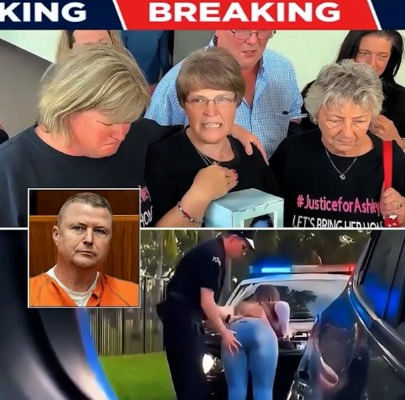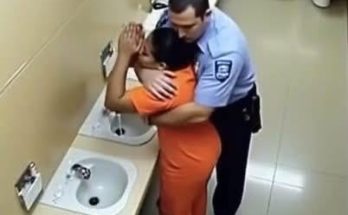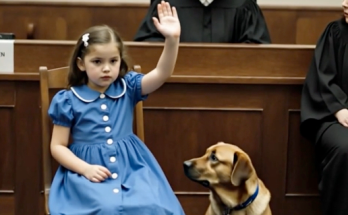In today’s digital age, videos captured by everyday citizens have become a crucial part of public discourse — shedding light on events that might otherwise remain unseen or misunderstood. One such video, recently shared widely across social media platforms, has captured the attention of thousands and ignited a powerful conversation about justice, accountability, and community resilience.
This particular video centers on a young woman who recorded police officers during a highly charged moment — doing so without their awareness. What unfolds in the footage is a deeply moving and, for many, a shocking interaction that has left viewers across the country reflecting on the broader implications for justice and transparency.
The Scene: United in Grief and Determination
At the heart of the video is a group of women, visibly emotional, standing shoulder to shoulder in solidarity. They wear matching shirts that bear the message “Justice for Ashleigh,” signifying a shared commitment to seek truth and accountability for a loved one. The atmosphere is heavy with grief, frustration, and a resolve that resonates through their unified stance.
One woman, surrounded by family and friends, steps forward with remarkable courage. Addressing the camera directly, she shares their story, speaking about the pain and confusion that has gripped their family and community. Her words convey not only personal heartbreak but also a powerful call for answers and justice.
The Controversial Detainment and Rising Questions
Within this emotionally charged scene, the video also captures a moment of police officers detaining a woman — an act that has triggered significant public concern. For many who have viewed the footage, this detainment raises pressing questions about the nature of police conduct, the treatment of individuals during such encounters, and the broader context surrounding the case.
The detained woman’s identity and the circumstances leading to her detainment remain partially unclear, fueling demands from the public and advocacy groups for greater transparency. The community’s reaction reflects a growing national conversation about law enforcement practices and the rights of individuals during police interactions.
The Central Figure: A Man Behind Bars
Adding to the complexity of the situation is a man seen wearing an orange prison jumpsuit, who has become the focal point of this family’s pursuit of justice. Though details about his connection to the case are still emerging, it is clear that he is central to the concerns driving the protests and calls for accountability.
The family and supporters have voiced their desire for clarity, demanding that authorities provide comprehensive information about his involvement and the circumstances surrounding the case. The video, in this sense, serves as both a document of grief and a catalyst for public inquiry.
Public Reaction: Voices of Outrage and Support
The release of the video has sparked a flood of responses online, with viewers expressing a mix of heartbreak, anger, and admiration for those standing up to seek justice. Comments across social media platforms illustrate the deep emotional impact of the footage, highlighting the widespread desire for truth and reform.
Many users wrote messages such as:
“This is heartbreaking to watch. How is this even happening in 2025?”
“She’s so brave for standing up like this. Justice NEEDS to be served.”
These reactions underscore the powerful role that citizen journalism plays in amplifying voices that might otherwise be overlooked and the importance of public engagement in matters of justice.
Authorities’ Response and the Ongoing Investigation
To date, law enforcement and relevant authorities have refrained from releasing the full details regarding the video or the specifics of the case it depicts. This has left room for speculation and analysis among social media users and independent investigators, some of whom believe the footage could significantly influence the direction of the investigation.
Officials have acknowledged the public interest and have promised transparency when possible, though no official statements have clarified the full sequence of events or the charges related to those involved.
The Role of Citizen Recordings in Modern Justice
This incident highlights a broader trend in which recordings by civilians have become instrumental in documenting real-time events and holding institutions accountable. Smartphones and digital platforms empower ordinary individuals to serve as witnesses and storytellers, often providing perspectives that traditional media may miss.
While such videos can be powerful tools for transparency, they also come with challenges — including concerns about privacy, the potential for misinformation, and legal considerations. Nonetheless, their impact on public awareness and justice reform continues to grow.
Social Media as a Platform for Advocacy and Awareness
The viral nature of this video demonstrates the significant role social media plays in shaping public discourse today. Platforms like Facebook, Twitter, and Instagram enable rapid dissemination of information and mobilize communities around shared causes.
The “Justice for Ashleigh” movement, as captured in the video, exemplifies how online and offline activism can intersect, combining personal stories with public demonstrations to demand accountability.
Mental Health, Community Healing, and Justice
Beyond the legal and procedural aspects, this case also touches on important themes of mental health and community healing. The emotional responses seen in the video speak to the profound human impact of such incidents — not only on those directly involved but also on families, friends, and neighbors.
Efforts to seek justice are often intertwined with the community’s need to process trauma and find pathways toward healing. Addressing systemic issues that contribute to these situations, including mental health support and social services, remains a critical component of broader reform.
Looking Forward: What Comes Next?
As the investigation progresses and more information becomes available, the public will be watching closely for developments. The video serves as a reminder of the power of transparency and community engagement in pursuing justice.
For many, the hope is that this moment will lead to meaningful change — both in the specific case and in the wider system — ensuring accountability, fairness, and respect for all individuals.
Conclusion
The viral video capturing the “Justice for Ashleigh” protest and police interaction is more than just footage; it’s a powerful narrative of grief, courage, and demand for truth. As authorities continue their work and the public calls for answers, this story embodies the ongoing struggle for justice that resonates far beyond the immediate community.
Stay connected for updates as this important story develops. Its implications may well influence conversations about law enforcement, transparency, and community activism for years to come.



